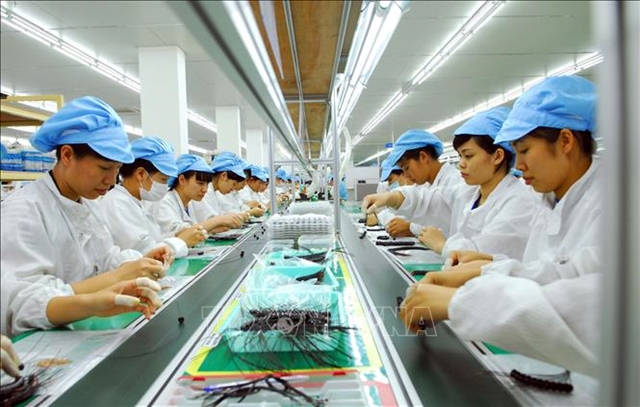 Economy
Economy


|
| An electronics production line at Bluecom Vina JSC at Tràng Duệ Industrial Park in the northern port city of Hải Phòng. — VNA/VNS Photo Danh Lam |
HÀ NỘI — The electronics industry has seen good progress in recent years, accounting for about 18 per cent of the total industrial production value and more than 30 per cent of the total export revenue of the country.
However, about 95 per cent of the export value of this industry still belongs to foreign-invested enterprises. Therefore, regulatory agencies need to research and issue breakthrough policies for the electronics industry to develop more sustainably and strongly.
In the 2016-20 period, exports of electronics, computers and components grew by an average of 23.8 per cent per year, according to the General Statistics Office, bringing Vietnam from 47th position in the world in 2001 to 12th, and third in the ASEAN region in terms of electronics exports.
In 2022, the electronics industry earned export revenue of US$114.4 billion, an increase of about 6 per cent compared to 2021 and accounting for more than 30 per cent of the total export revenue of the country.
The outstanding development of the electronics industry is mainly due to the attraction of large investments from multinational corporations, the Republic of Korea and Japan in the field of manufacturing electronic components.
But the consequence is that the industry is also heavily dependent on foreign investors when up to 95 per cent of export revenue belongs to FDI enterprises. The capacity of domestic enterprises remains limited, and the domestic electrical-electronics market is dominated by foreign brands.
Besides, the localisation rate of the electronics industry is still low. Most electronic products on the Vietnamese market are imported complete units or assembled domestically with foreign components. Although domestic supporting enterprises have participated in the value chain of the industry, they can only provide simple products with low technological value. Vietnam's electronics industry is still at the assembly stage in the electronic production chain.
Explaining the cause of this situation, Deputy Director of the Industry Department Phạm Tuấn Anh said that electronic products often have a relatively short lifespan, with features and designs quickly changed, while domestic enterprises have limited capacity and lack resources to invest in the research and development of products as well as brands.
Therefore, production stages with high value-added content still depend on foreign production chains. On the other hand, due to the low production capacity of domestic enterprises, product quality has not yet met the high requirements of FDI enterprises, leading to a lack of linkages between suppliers and multinational corporations.
After the COVID-19 pandemic and a series of socio-economic upheavals in the world and the region, Việt Nam's electronics industry is facing an opportunity to welcome a new wave of investment and to restructure the value chain in the near future.
Many large corporations in the world such as Apple, Pegatron and Intel have expressed interest and plans to invest in or expand the production of electronic products in Việt Nam, including some products with high technology content. Samsung is looking for more domestic suppliers to increase the linkage in the value chain of the group in Việt Nam.
However, to tackle the challenges facing the electronics industry, the State needs to promptly adjust its FDI attraction policy to effectively take advantage of the wave of production shifting to Việt Nam. Support policies are also needed to help support enterprises improve their competitiveness and promote digitalisation.
Deputy Director Anh said it is necessary to develop a long-term support strategy to help transform the industry from simple assembly to manufacturing high-value-added products. First, it is necessary to promote the development of products such as displays, semiconductors and key electronic components.
Electronic businesses themselves should pay more attention to identifying core and breakthrough products, as well as focus their resources on products with good competitiveness. — VNS




